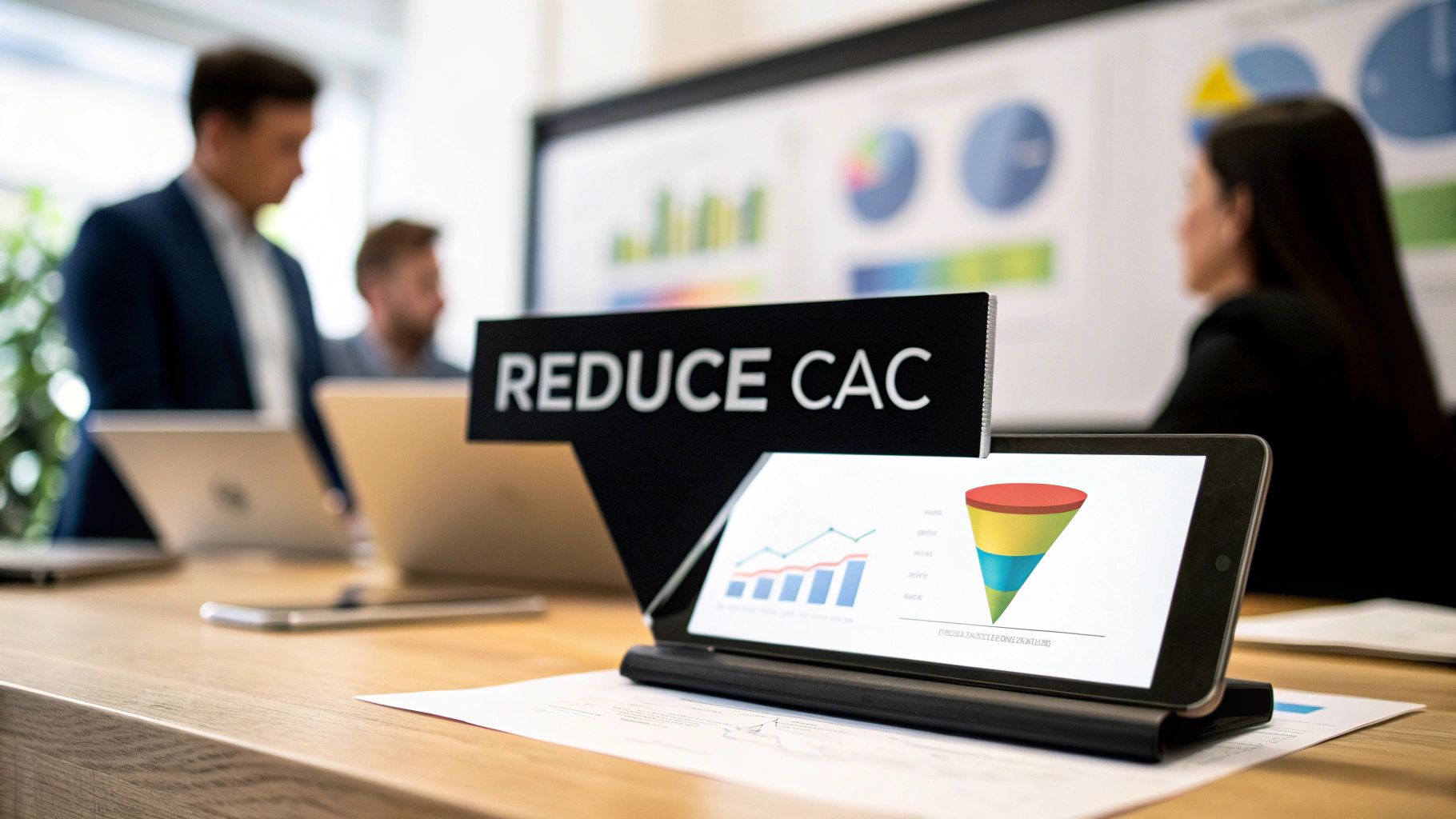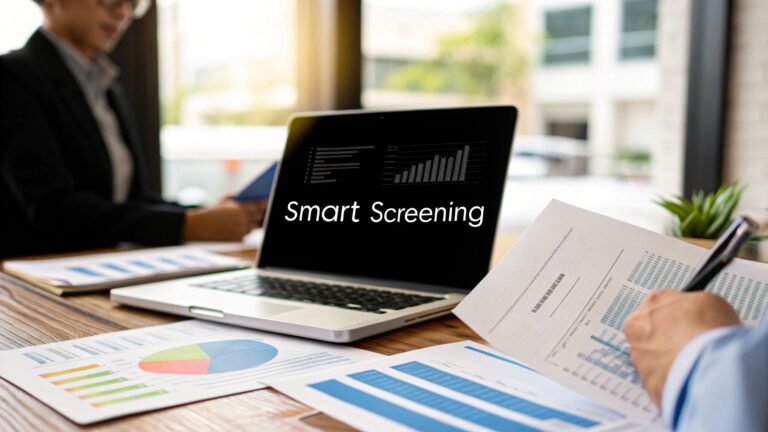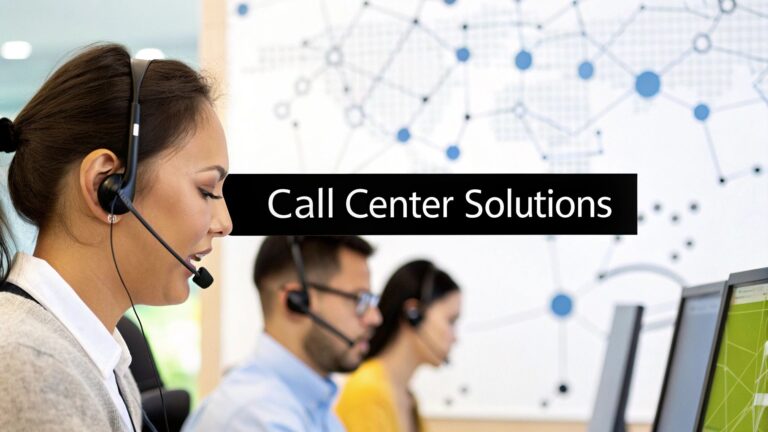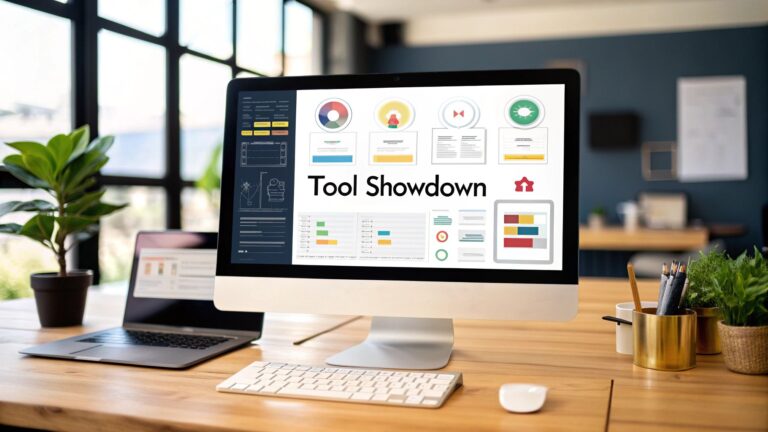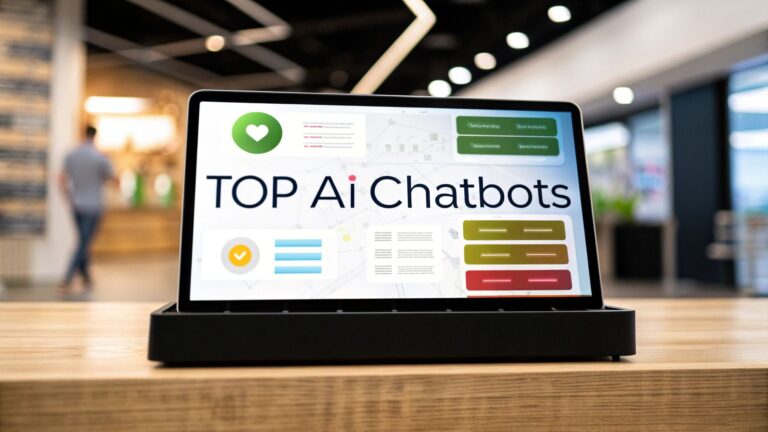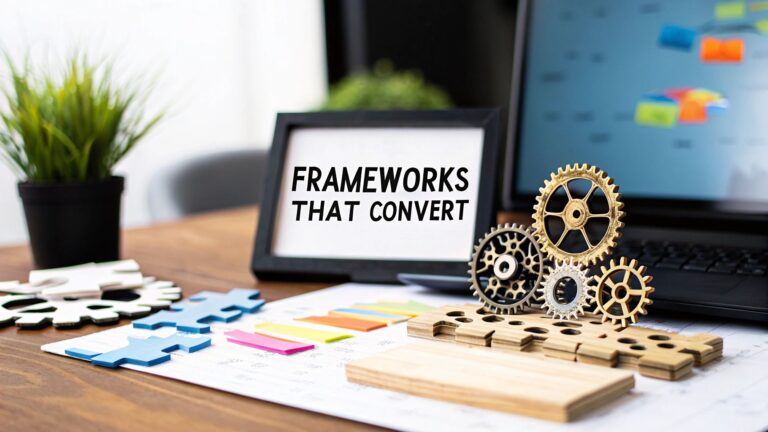How to Reduce Customer Acquisition Cost in B2B
If you want to get a handle on your customer acquisition cost, you first have to get brutally honest about what you’re actually spending. I’m not just talking about ad spend. You need a complete, unfiltered look at every expense tied to winning a new customer—salaries, software, overhead, you name it.
Without this true baseline, any attempt to lower your CAC is just a shot in the dark.
Establishing Your True Customer Acquisition Cost
Before you can start trimming the fat, you need to know exactly how much fat there is. Too many B2B and SaaS companies glance at their monthly ad spend, divide it by the number of new logos, and call that their CAC. That’s a recipe for disaster.
This isn’t just some accounting chore; it's the bedrock of sustainable growth. A sky-high CAC is a red flag, pointing to a leaky sales funnel, a broken channel strategy, or a fundamental mismatch between your marketing and your ideal customer. Nail this number, and you can finally invest with confidence in the channels that actually make you money.
Moving Beyond Simple Ad Spend
To paint an accurate picture, you have to track every single dollar that helps land a new customer. Think of it as a full financial audit of your entire growth engine.
This means you need to include:
- Team Salaries: The fully-loaded cost of your sales and marketing folks for a given period (don't forget benefits and taxes).
- Tool Subscriptions: Every piece of software involved—your CRM, marketing automation, analytics platforms, and sales intelligence tools.
- Creative and Content Production: The real cost behind your ad creative, blog posts, case studies, videos, and landing page designs.
- Overhead Allocation: A fair slice of the rent, utilities, and other general business expenses that support your growth teams.
To really get this right, let’s break down the core components you can't afford to miss. These are the details that separate a vanity metric from a true north star for your business.
Core Components for an Accurate B2B CAC Calculation
| Metric Component | Description | Real-World Example |
|---|---|---|
| Marketing & Sales Salaries | Fully-loaded cost (salary, benefits, commissions) for everyone involved in acquisition. | A $80k marketer's true cost might be closer to $100k after payroll taxes and benefits. |
| Advertising Spend | Direct costs for all paid channels—PPC, social ads, sponsorships, etc. | Your $20,000 monthly spend on LinkedIn and Google Ads. |
| Content & Creative Costs | Expenses for creating assets, including freelancer fees, agency retainers, or internal time. | Paying a freelance writer $500 for a blog post or an agency $5,000 for a video ad. |
| Software & Tool Subscriptions | The monthly or annual cost for your entire martech and salestech stack. | Your HubSpot CRM at $1,200/mo, an outreach tool at $100/mo, and analytics software at $300/mo. |
| Allocated Overhead | A proportional share of general business expenses like rent, utilities, and office supplies. | If sales/marketing is 20% of your team, they get 20% of the $10,000 monthly office rent. |
Once you’ve gathered all these numbers, you’re ready to calculate a CAC that means something. For a deeper look at the formulas, our guide on https://makeautomation.co/saas-customer-acquisition-cost/ offers some great frameworks. You can also master your Customer Acquisition Cost Calculation with a full breakdown of what to include.
The Three-Step CAC Audit Process
Trying to tackle this all at once can feel overwhelming. Breaking it down into a clear, methodical process is the key to getting it right without losing your mind. A structured audit helps you gather, calculate, and analyze your costs to uncover insights that would otherwise stay buried in a spreadsheet.
This visual gives you a simple flow for performing a thorough CAC audit from start to finish.
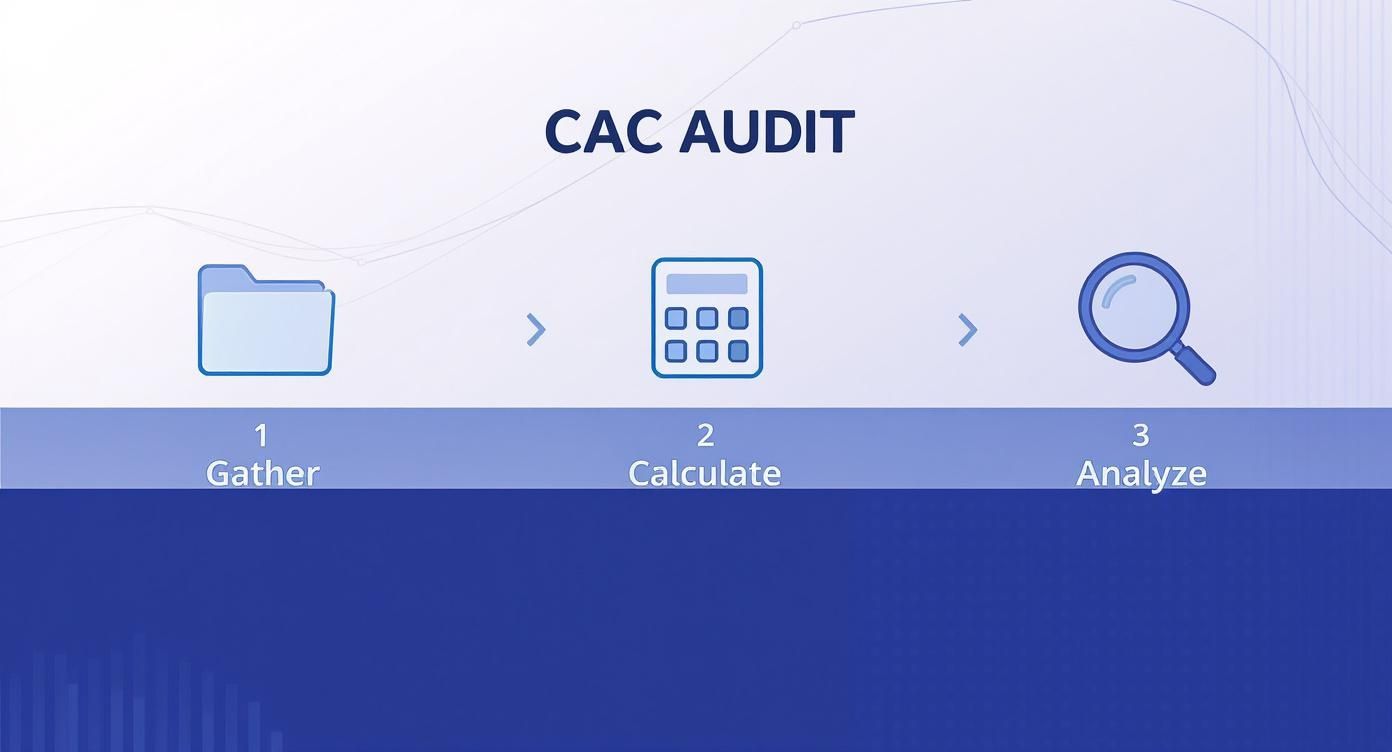
Following a process like this turns raw financial data into a powerful weapon. You can see exactly where every dollar is going and what it’s bringing back.
From there, the real magic happens when you segment this data by channel, campaign, or even customer persona. This is how you discover which of your brilliant ideas are driving profitable growth and which ones are just expensive hobbies.
Key Takeaway: An accurate, all-inclusive CAC is more than a metric—it's a diagnostic tool. It reveals the true health of your growth strategy and points you directly to the areas that need fixing.
Plugging Leaks in Your Acquisition Funnel
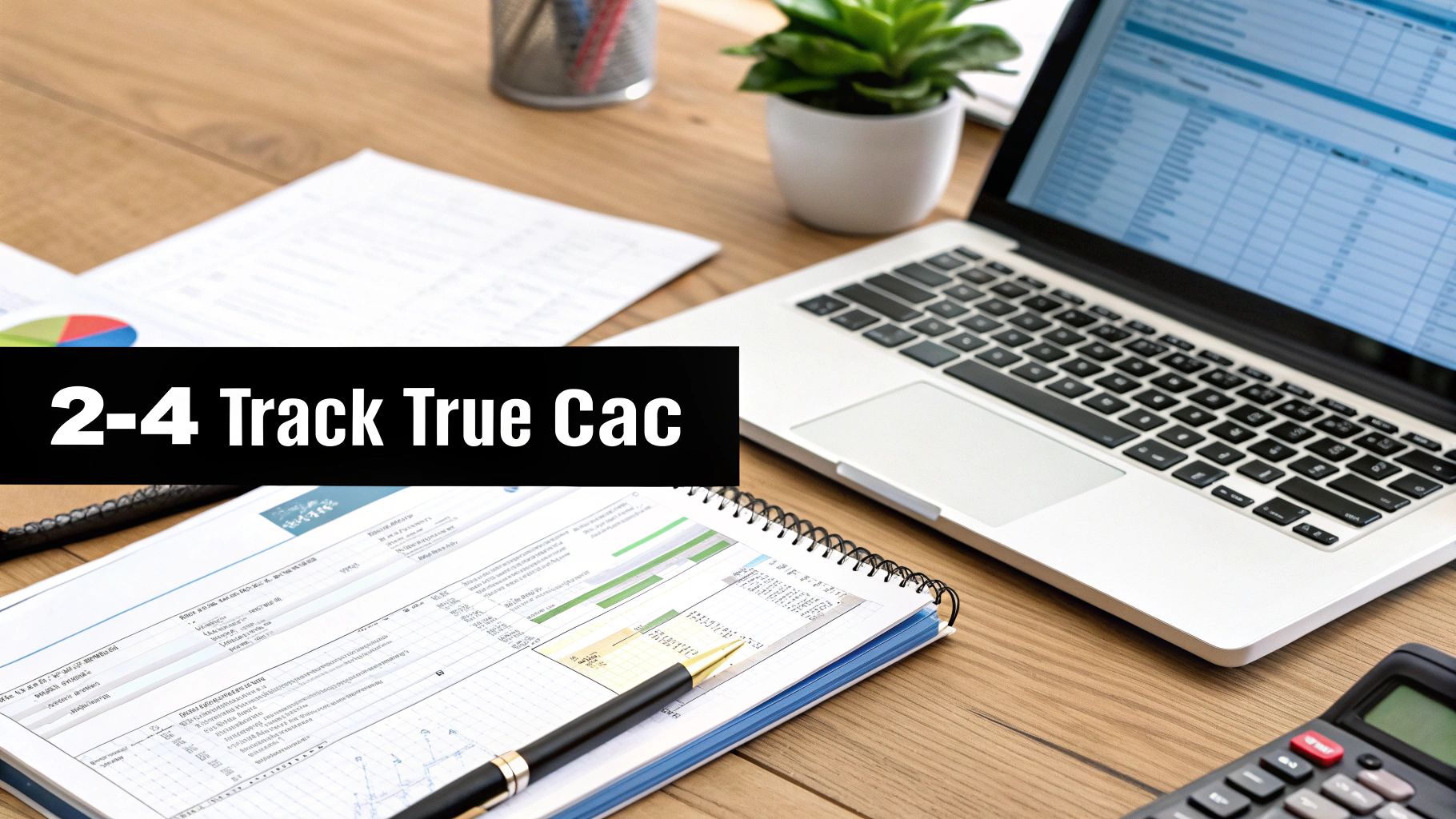
A high Customer Acquisition Cost isn't usually caused by one single thing. It’s almost always a symptom of a leaky acquisition funnel, where good leads just vanish before they ever get a chance to convert.
Imagine your funnel is a bucket with a dozen tiny holes. Fixing just one won't stop you from losing water. You have to find and seal all the cracks, from top to bottom.
The real goal here isn't just to pour more traffic into the top. It's about getting more value from the traffic you already have. When you optimize each stage of the customer journey, you convert a higher percentage of prospects, which directly slashes the cost to acquire each one.
Refining Your Top-of-Funnel Targeting
The first—and often most expensive—leaks happen right at the start. This is where you burn cash on ads shown to people who were never going to be a good fit. Your best defense is simply better targeting.
Stop running broad campaigns aimed at a general industry. Instead, get specific with job titles, company sizes, and even the tech stacks your ideal customers use.
For instance, a company selling project management software shouldn't just target "software companies." A much smarter play is to target "Project Managers" at "SaaS companies with 50-200 employees" who use a specific, complementary tool. This instantly filters out the noise and focuses your budget where it counts.
Here are a few ways to sharpen your aim:
- Use Negative Keywords: Actively block search terms in your paid campaigns that attract the wrong crowd. If you sell enterprise software, excluding words like "free," "cheap," or "small business" can save you a surprising amount of money.
- Build Lookalike Audiences: Take the data from your best customers and use it to find new prospects on platforms like LinkedIn and Facebook. The platform's algorithm does the heavy lifting, finding people who share the same DNA as your most profitable clients.
- Go All-In on ABM: For high-ticket B2B sales, Account-Based Marketing is a game-changer. Create a hand-picked list of target companies and run hyper-personalized campaigns just for them. It flips the traditional funnel on its head, focusing all your energy on pre-qualified accounts.
By bringing in better-quality leads from the get-go, you radically increase the chances they'll make it through the funnel.
Middle-Funnel Optimizations That Actually Convert
Once a prospect hits your site, the mission shifts to conversion. This is where tiny tweaks can produce massive results. The enemy here is friction—every extra form field, confusing headline, or slow-loading page is another leak.
I once worked with a company whose demo sign-up rate was stuck at a painful 1.5%. Their landing page was a wall of text with a generic headline and a form that demanded seven different pieces of information.
We ran a simple A/B test. The new version had a benefit-driven headline ("Cut Project Reporting Time by 50%"), a form with just three fields (name, email, company), and a few customer logos for social proof. The result? The conversion rate shot up to 4.2%. They more than doubled their qualified leads without spending another dime on ads.
Small tweaks at your key conversion points can have an outsized impact on CAC. Halving the friction on a landing page can literally halve your cost per lead.
Removing Bottom-Funnel Friction
The final hurdle—turning a qualified lead into a paying customer—is where so many deals stall out. A drawn-out contracting process, an opaque pricing page, or a clunky checkout flow can easily scare away an otherwise enthusiastic buyer.
Your job is to make saying "yes" as easy as possible.
- Simplify Your Pricing: Use clear, tiered pricing that people can understand at a glance. Get rid of hidden fees or confusing add-ons that force them onto a sales call.
- Streamline Onboarding: For SaaS products, a self-serve checkout and automated onboarding can completely remove the sales bottleneck for smaller customers. This frees up your sales team to focus their energy on closing bigger enterprise deals.
- Offer Flexible Terms: Can you offer monthly plans instead of forcing everyone into an annual contract? Can your legal agreement be simplified into plain language? Removing these barriers shortens the sales cycle and cuts down the internal costs tied to closing a deal.
Each of these optimizations helps you get the maximum value from every lead you fought so hard to attract. For a deeper dive, you can explore these additional sales funnel optimization strategies to plug even more leaks.
Using Automation and AI to Boost Efficiency
Let's talk about a massive hidden cost in your customer acquisition engine: manual, repetitive tasks. Every single hour your sales team spends logging data in the CRM or your marketing team spends slicing and dicing email lists is an hour they aren't spending on high-value work—like actually closing deals or mapping out a killer campaign strategy.
This is precisely where automation and AI stop being buzzwords and start becoming your secret weapon for slashing CAC. By swapping out those time-sucking tasks with intelligent systems, you empower your team to focus on what humans do best: building relationships and thinking strategically. It’s not about replacing people; it’s about making them better, faster, and more effective at their jobs.
Automating Lead Qualification and Nurturing
One of the biggest black holes for time and energy in any sales process is chasing down and qualifying leads. An SDR can easily burn hours every day calling and emailing prospects who are a poor fit, don't have the budget, or just aren't ready to talk.
It’s a grind. But intelligent automation can do most of that heavy lifting for you.
- 24/7 Chatbots: Get an AI-powered chatbot on your website to engage visitors the second they land. These bots can handle initial qualifying questions, book demos for the hot leads, and route conversations to the right person. No more missed opportunities, even at 2 a.m.
- Predictive Lead Scoring: Stop treating every lead the same. AI can score prospects based on their likelihood to actually buy, analyzing everything from company data to their on-site behavior. This automatically surfaces the highest-value leads so your team can focus their energy where it counts.
- Automated Nurture Sequences: What about the leads who aren't quite ready? Set up automated email and messaging workflows to keep them warm. These sequences can drip out valuable content over time, building trust and keeping you top-of-mind until the timing is right.
Here's a great example from Salesforce Einstein showing how AI can analyze sales data to predict which deals will close and suggest what to do next.
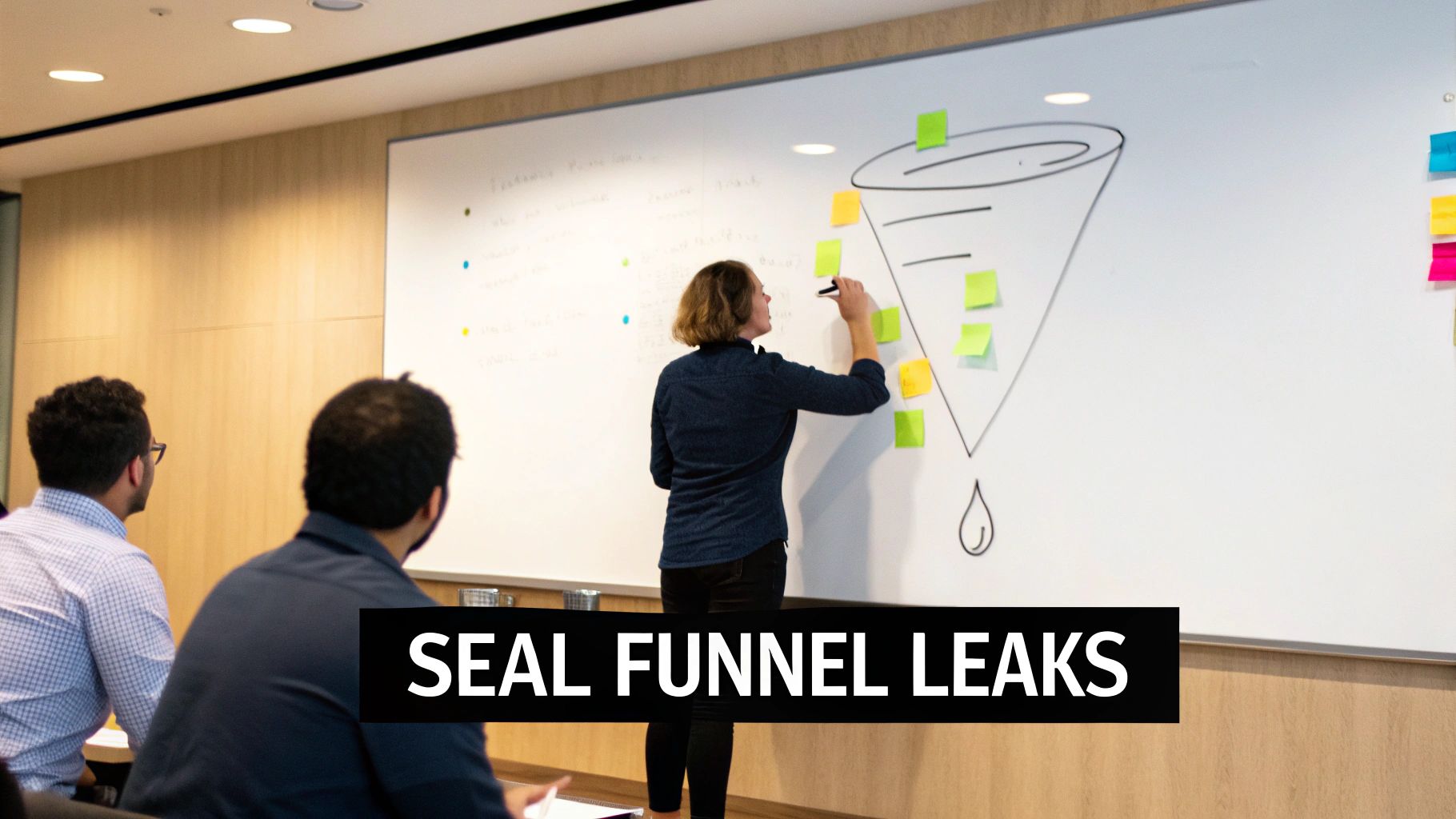
Tools like this shift your sales team from being reactive to proactive, guiding them toward the opportunities with the best shot at success.
Streamlining Outreach and Follow-Up
Everyone knows that consistent follow-up is what turns leads into customers. It's also incredibly tedious to manage by hand. Trying to manually track who to call, when, and with what message is just asking for things to fall through the cracks. This is a problem that CRM automation was built to solve.
You can create workflows that automatically set follow-up tasks, send personalized email templates, and ping a sales rep when a prospect revisits the pricing page. It ensures a persistent and perfectly timed approach without all the manual grunt work.
Businesses that bring AI into their customer acquisition have seen their CAC drop by up to 50% in industries like e-commerce, fintech, and SaaS. With acquisition costs more than tripling since 2013, brands now lose an average of $29 for every new customer they acquire. That makes the efficiency gains from AI absolutely critical. You can find more on these rising costs on amraandelma.com.
These aren't just marginal gains. They come from AI's ability to fine-tune targeting, automate segmentation, and personalize outreach on a scale that a human team could never dream of achieving.
Implementing AI-Powered Acquisition Tools
Getting started doesn't mean you need a massive budget or a team of data scientists. A lot of modern tools are built for growth-stage teams and can deliver value almost immediately. For a more detailed breakdown, our guide on AI-powered lead generation offers some great frameworks.
Here are a few high-impact, low-cost ways to get started:
- CRM Workflows: The lowest-hanging fruit is almost always right inside your existing CRM, whether it’s HubSpot or Salesforce. Start by building simple sequences to automate follow-up reminders or update lead statuses.
- Voice AI Agents: Look into AI agents for inbound or outbound calls. These tools can handle the initial qualification chat, answer common questions, and get appointments on the calendar, freeing up your team for the more nuanced conversations.
- Intelligent Outreach Tools: Platforms like Apollo.io or Outreach use AI to help you identify the best prospects, test your messaging, and run automated outreach campaigns across both email and social media.
By strategically layering in these technologies, you can transform your acquisition process from a manual, labor-intensive slog into a sleek, data-driven machine. You don't just lower your direct costs—you also speed up your entire sales cycle, which means those efficiency gains start to compound over time.
Increasing LTV to Justify Acquisition Spend

Fighting to lower your Customer Acquisition Cost is only half the battle. A more powerful, and often overlooked, strategy is to flip the equation on its head. Instead of just cutting costs, focus on increasing the value of each customer you bring in.
When a customer's Lifetime Value (LTV) goes up, your current CAC suddenly looks a lot more sustainable, even profitable. This approach shifts your focus from a frantic chase for new leads to a more deliberate strategy of retention and expansion. It’s about getting more from the customers you already fought so hard to win, building a resilient growth model that isn't totally dependent on finding the next new logo.
Crafting a World-Class Onboarding Experience
The first 90 days are make-or-break. This is where you either set customers up for long-term success or lose them to early churn. A clunky, confusing, or unsupported onboarding process is one of the fastest ways to destroy LTV before it even has a chance to grow.
Your primary goal here is to get the customer to their "first win" as quickly as possible—that magic moment where they experience the core value of your product and get why they bought it.
To make that happen, you need to be hands-on.
- Personalized Kick-Off Calls: Ditch the generic welcome email. A brief, personal call to align on expectations sets a completely different tone for the relationship.
- In-App Guided Tours: Don't just dump a new user into a complex interface. Use interactive walkthroughs to guide them through the essential features they need to see value.
- Proactive Check-Ins: Schedule automated emails or a quick call from a customer success manager at key points, like Day 7 or Day 30, just to make sure they're on the right track.
A smooth onboarding experience doesn't just cut down on churn; it creates power users who are primed for future expansion. It's your first, best chance to prove the value you promised during the sales process.
Identifying and Acting on Upsell Opportunities
Once customers are successfully onboarded and using your product, it's time to look for expansion revenue. Upselling and cross-selling are some of the most efficient ways to boost LTV because you're selling to a warm, engaged audience. This is a core part of learning how to reduce customer acquisition cost without just grinding away at top-of-funnel metrics.
The trick is to be helpful, not pushy. You need to use data to spot the perfect moments to introduce a higher-tier plan or a valuable add-on.
Keep an eye out for these buying signals:
- Hitting Usage Limits: Is a customer constantly bumping up against the limits of their current plan? That’s a classic trigger for an upgrade conversation.
- Asking About Features: If they’re asking your support team about functionality that's only available in a higher tier, you’ve got a clear buying signal right there.
- Watching Them Grow: Monitor your customers' company news. If they’ve just raised a round of funding or announced a big hiring push, they're probably going to need more powerful tools.
A healthy SaaS business should aim for an LTV to CAC ratio of at least 3:1. For every dollar you spend to acquire a customer, you need to generate at least three dollars back. Focusing on smart upsells is one of the fastest ways to hit and exceed that benchmark.
Activating Your Customer Base for Referrals
Your happiest customers can become your most effective—and lowest-cost—acquisition channel. A formal referral program takes that random word-of-mouth chatter and turns it into a predictable pipeline of high-quality leads. These leads almost always have a much lower CAC because they arrive with built-in trust and social proof.
A great referral program doesn't have to be complicated. It just needs structure and the right incentives.
Try a simple two-sided model:
- The referrer (your current customer) gets a credit, discount, or gift card for bringing in a new customer.
- The new customer gets a discount on their first month or year, making it an easy "yes" for them to sign up.
By strategically building out these three pillars—onboarding, upselling, and referrals—you create a powerful growth loop. You're no longer just acquiring customers; you're investing in relationships that pay dividends long after the initial sale, making your entire acquisition engine more profitable and robust.
Let Your Product Do the Selling with Product-Led Growth
For a lot of B2B and SaaS companies, the single most powerful way to slash customer acquisition costs is to get out of the way and let the product sell itself. That’s the entire philosophy behind Product-Led Growth (PLG). It’s a shift in mindset where your product, not your sales team, becomes the primary engine for acquiring new customers.
Instead of trying to convince prospects with polished slide decks and scheduled demos, you give them direct, hands-on access. They get to experience the product's value firsthand, which completely changes the conversation. This approach replaces expensive, high-touch sales cycles with self-serve options like freemium plans, free trials, and interactive tours that let users discover the value on their own terms.
How the Product Drives Acquisition
The real beauty of PLG is how it aligns your product's value with a user's actual needs. Prospects don't have to take a salesperson's word for anything; they can see for themselves if your tool solves their problem. This self-qualification process is incredibly efficient and cost-effective.
Think about the traditional sales-led grind. An SDR spends their day chasing leads, trying to qualify them, and booking demos with people who might not even be a good fit. It's slow, manual, and burns through cash.
Now, compare that to a PLG motion:
- Freemium: Users can sign up for a free, slightly limited version of your product. As they start relying on it and hit certain usage caps, upgrading to a paid plan feels like a natural and obvious next step.
- Free Trials: You give a prospect the keys to the kingdom with full access for a limited time, usually 14 or 30 days. This gives them plenty of time to explore every feature and confirm its value before pulling out their credit card.
- Interactive Demos: Instead of a live, one-to-many demo, you can offer a self-guided product tour. This lets users learn at their own pace and focus on the features that matter most to them.
These pathways let you engage a massive audience for a tiny fraction of the cost of a traditional sales team, making them a game-changer for anyone looking at how to reduce customer acquisition cost.
Using In-Product Data to Pinpoint Opportunities
Once users are active in your product, you have a direct window into their behavior. This is where PLG really starts to shine. In-product analytics become your secret weapon, helping you spot engaged users who are ready to convert without any guesswork.
You can stop worrying about vanity metrics like email open rates and start tracking what really matters: how people are using your product.
Companies that embrace PLG with freemium plans, free trials, or in-app tutorials often see a major drop in CAC. Why? Because users who experience the value firsthand are far more likely to convert and tell others, all without a heavy marketing push. When SaaS companies use product data to find upsell opportunities and smooth out their onboarding, they can shorten their payback period and boost LTV, which makes their CAC even more efficient. You can find more insights on PLG and its impact on acquisition costs on DevRev.ai.
This data shows you exactly who your power users are and which actions signal they're ready to buy. From there, you can automate the next step by triggering a targeted in-app message, an upgrade prompt, or even a timely email from a product specialist.
Building a Self-Sustaining Growth Engine
The ultimate vision for PLG is to create a growth loop that practically runs itself—where the product not only brings in new users but also empowers them to bring in others. This is done by weaving viral and referral mechanisms directly into the user experience.
Here’s a breakdown of how that works:
- Inherent Virality: Some products are just better when used with others. Think about collaboration tools like Slack or Figma. Inviting a teammate isn't just a feature; it's a core part of getting work done.
- Referral Programs: You can actively incentivize users to spread the word. Dropbox famously gave users extra storage space for every friend they referred, a simple tactic that fueled its legendary early growth.
When you embed these kinds of loops, your product starts marketing itself. Every new user has the potential to bring in several more, creating an exponential growth curve that dramatically reduces your dependency on paid ads. Your product evolves from just a tool into a powerful, cost-effective growth machine.
Common Questions About Reducing CAC
https://www.youtube.com/embed/jvOZMQYjYYY
Even with a solid plan, trying to lower your customer acquisition costs can feel like navigating a maze. I've found that B2B and SaaS leaders often run into the same roadblocks and questions as they try to make their growth more efficient.
Let's break down some of the most common ones I hear and give you some clear, practical answers to point you in the right direction.
What Is a Good LTV to CAC Ratio for a B2B SaaS Company?
For a B2B SaaS company to be in a healthy spot, the gold standard for the LTV to CAC ratio is 3:1 or higher. Think of this as your north star for sustainable growth. It's a simple way to confirm that for every dollar you spend getting a new customer, you're making at least three dollars back over their lifetime.
If you see that ratio dipping below 3:1, it’s a warning sign. Your business model might not be sustainable if your acquisition costs are chewing up too much of your revenue. On the flip side, if you're hitting a ratio of 5:1 or more, you’ve built an incredibly efficient growth engine. This isn't just a metric to check once a quarter; it's a vital sign for your business that you should be watching all the time.
A healthy LTV:CAC ratio is your permission to scale. When you know each new customer is profitable, you can invest in growth with confidence, not anxiety.
Getting this ratio right is what allows you to pour money back into your product, your marketing, and your team, creating a powerful cycle of growth.
How Long Should My CAC Payback Period Be?
You should be aiming to get your money back on a new customer in under 12 months. That’s the ideal CAC payback period for a B2B SaaS company.
A shorter payback window—say, five to seven months—is even better. It frees up your cash flow and lets you put that capital right back into growing the business much, much faster. It's like shortening the feedback loop for your marketing spend.
Once that payback period starts creeping past 18 months, you’re likely feeling the financial strain. That’s a clear signal you need to either bring your CAC down, find ways to increase your initial contract value, or plug the leaks by improving retention in those crucial early months.
Which Marketing Channels Typically Have the Lowest CAC?
The channels that consistently deliver the lowest long-term CAC are the ones built on organic growth and relationships you already have. These are assets you build over time, not just rent from an ad platform.
From what I've seen, here are the most cost-effective channels:
- Content Marketing & SEO: This one takes a real upfront investment of time and effort. You have to create truly valuable content and build up your website's authority. But the cost of that initial work gets spread out over thousands of future customers who find you on their own.
- Word-of-Mouth Referrals: Leads from happy customers are pure gold. They're often the highest quality and come with a direct acquisition cost that's close to zero. Building a simple referral program can turn this from a happy accident into a predictable, low-cost channel.
- Direct Traffic: This is the payoff for building a strong brand. When people know your name and type your URL directly into their browser, the cost to acquire them is effectively zero.
Paid channels like Google Ads and LinkedIn Ads are great for getting immediate results and targeting with precision, but you pay a direct cost for every single click and conversion.
The most sustainable strategies I’ve seen always strike a balance. They use paid channels for short-term wins while investing in organic channels to build a cost-efficient growth machine for the long haul. For a deeper dive, check out these 5 proven strategies to reduce customer acquisition cost that go into more detail.
At MakeAutomation, we specialize in implementing the exact AI and automation frameworks that slash acquisition costs and accelerate growth. If you're ready to stop wasting time on manual tasks and build a more efficient, scalable business, book a consultation with us today.

